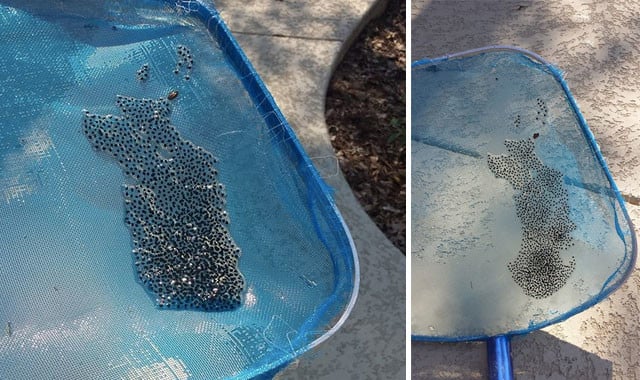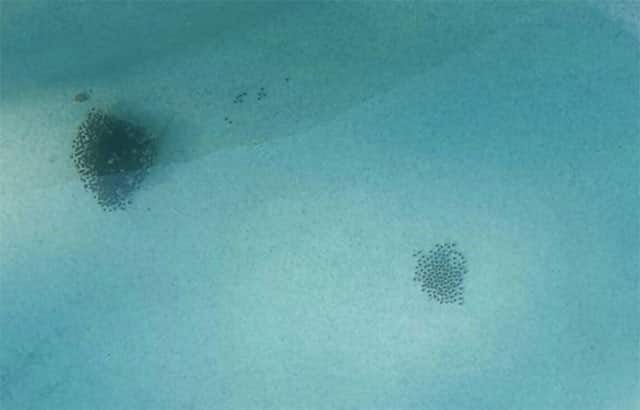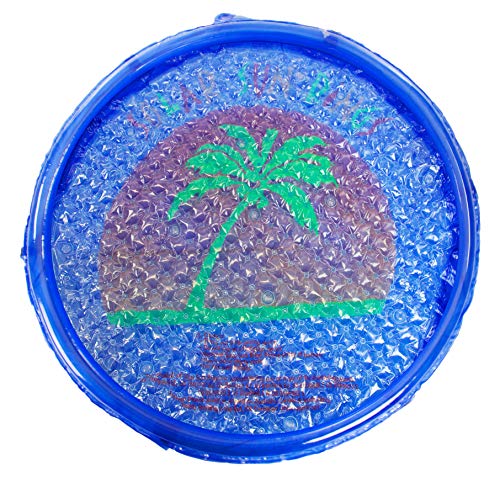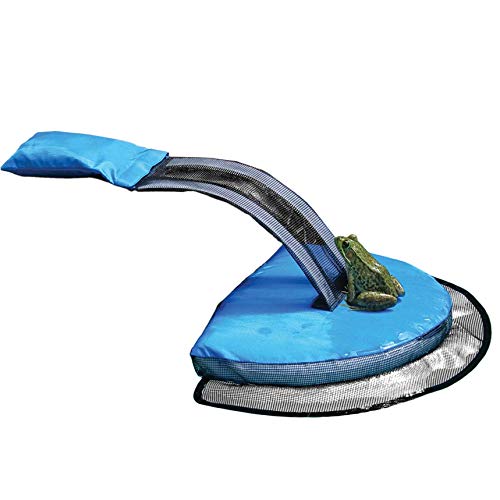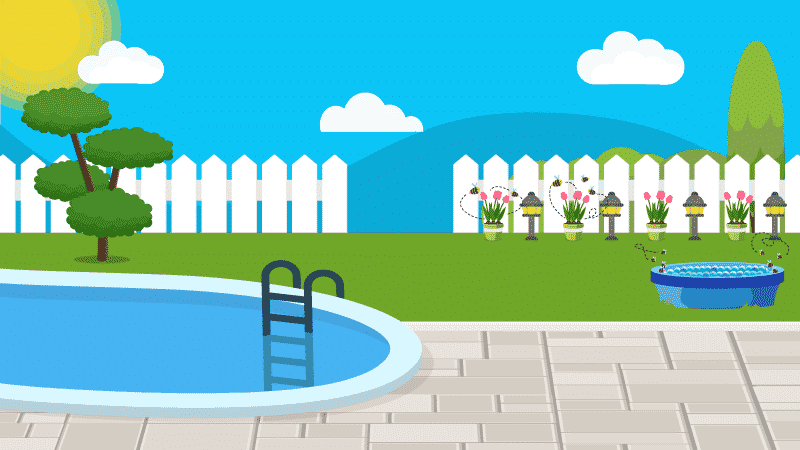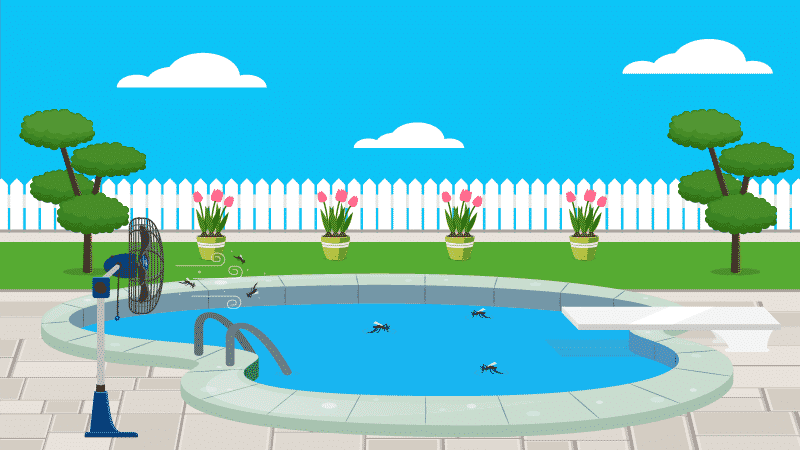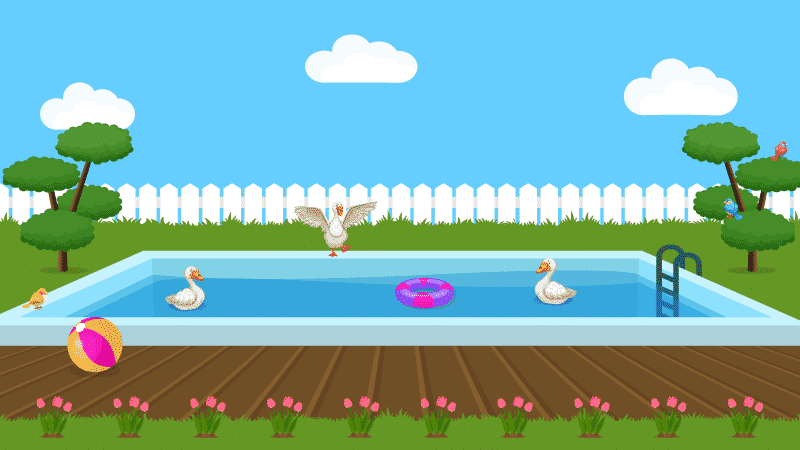How to Keep Frogs Out of Your Pool
As far as frogs are concerned, that’s not a pool in your back yard. It’s a big ol’ pond where they can hang out, eat bugs, and do all their froggy business.
The problem is, because it’s not actually a pond with a gradual slope, frogs can find their way into the pool, but be unable to get out again. Then you end up with poor froggy bodies floating in the water. To prevent it, take some time to learn how to keep frogs out of your pool.
Why Do You Have Frogs in Your Pool?
Because they don’t know the difference between a clean, chlorinated pool full of water and a natural, murky pond. Even more than that, it’s because your pool can be a bountiful source of food for them.
Some insects are also attracted to water. A bunch of flying, water-loving bugs hovering around your pool is like a big, buzzing buffet to a frog. Lily pad for two, please!
And at night, when light reflects off the water, or you have pool lights on, the light will attract more bugs, which is just a second course for your froggy pals.
That’s right, we said pals. You actually want frogs in your yard and garden. Just not in your pool.
Why Don’t You Want Frogs in Your Pool?
The fact is, frogs are actually doing you a favor by keeping some of those six-legged, flying pests away from and out of your pool.
And they’re not poisonous, despite some rumors you may have heard. They may be carrying some bacteria on their bodies from hanging out on the ground and in the dirt, but as long as your water is properly balanced, the sanitizer should take care of that.
There are two other, much better reasons you don’t want frogs in your pool.
They May Lay Eggs in the Water
Because frogs are amphibians and not mammals, they reproduce by laying eggs, which turn into tadpoles, which grow into adult frogs. But rather than laying their eggs just anywhere, they must lay them in water.
Frog eggs don’t have a hard shell-like reptile and bird eggs do. If they were left out on the ground, in the open air, they’d dry out, killing the tadpoles inside.
A pool owner reached out to us on Facebook and sent us these photos. She had no idea what she was skimming out of her pool.
If you’ve never seen them before, those are frog eggs. Lots of them. Depending on the species, a mature female frog can lay anywhere from 2 to 50,000 eggs at once. Once the frog lays her eggs, they’ll likely sink to the bottom of your pool, suspended in a jelly-like cloud.
If you find frog eggs in your pool, simply skim them out and find a more suitable place for them away from your pool. If there’s a pond on your property, that would be ideal. If not, you could put them in a shallow kiddie pool filled with just enough water to cover the eggs.
They May Die in Your Pool
Once frogs get into the water, they can’t always get out because the pool edge is too high for them to jump to from the water, and they can’t see the steps.
Even if they could see the steps, their little froggy brains may not make the connection with them being an exit. They’ll desperately swim around and around the pool, looking for a way to get out until they become exhausted and drown. Then you’ll come out the next day and find a little froggy body floating in your pool, or possibly in the skimmer.
This would be sad, but let’s be honest—it would also be kind of gross to have to dispose of a dead frog. So your best bet is just keeping them out altogether.
How to Keep Frogs Out of the Pool
Posting a sign won’t be enough. Frogs are known to ignore signs telling them not to do things. They’re contrary that way. But you have several other options available to you.
Install a Fence
If you don’t already have a pool fence installed, it can do a lot more than just provide safety and security. In addition to keeping small kids, pets, and cheeky neighbors out of your pool area, it can prevent all manner of critters from finding their way into the water as well.
Just be sure to choose the right type of fence. Iron bars or chain link? The frogs will laugh their throaty laughs while they hop right through those. Your best bet will be solid wood or vinyl fencing.
Use a Cover
At night or whenever you’re not using your pool, consider covering it. This will help keep bugs out of your pool, and the fewer bugs in the pool, the less frogs will try to get into it. A regular pool cover should be easy to install and remove, but still fastened securely so children and animals can’t accidentally slip under it and get trapped in the pool.
For extra peace of mind, consider using a pool safety cover. They’re made specifically to keep things from falling into the pool. And because they’re pulled taut, it’s also difficult to impossible for anything to squeeze in between the cover and the ground.
This solar blanket will increase the water temperature by about 15 degrees and prevent up to 95% of pool water and chemical evaporation. This reduction of evaporation is environmentally friendly, save you time, and money. Comes with a 6-year manufacturer warranty.
Pull the Weeds
A dense patch of weeds is almost as inviting to a frog as your pool is. It’s a good place to hide until they’re ready to jump into the pool.
Next time you go out to do a little pool landscaping, clear the area around your pool deck of weeds and tall grass.
You may see advice to use ammonia-based fertilizer to reduce the frog population in your yard. It does that by killing them. Ammonium nitrate fertilizer is highly toxic to frogs, and they’ll die a horrible, painful death if exposed to it.
If you don’t want to scoop dead frogs out of your pool, you definitely don’t want to pick them up from your garden. There’s no need to kill them. Remember, they eat lots of bugs. Just divert them away from the pool with other tactics.
Turn Off Lights
Sure, it may look nice at night to have the pool lights and landscaping lights on in the back yard. But it’s also an invitation to bugs, which is, by extension, an invitation to frogs.
When you’re not using the pool, turn all the lights off in and around it. No bugs, no frogs.
Install a Water Feature
Insects aren’t crazy about moving water. They prefer still, stagnant water because it’s an ideal place to lay their eggs. The more eggs they lay, the more insects you’ll have, which means the more frogs you’ll have as well.
Pool fountains and waterfalls that move the water around will prevent insects from getting too comfortable in the water. They’ll move on, and so will the frogs.
Heat the Water
Why do frogs prefer cold water? No, it’s not because they’re cold-blooded. It’s because it’s how they get oxygen into their blood.
A frog’s skin is permeable, which allows them to absorb oxygen directly through their skin. Cold water holds more dissolved oxygen than warm or hot water.
So the colder the water, the more oxygen it has, and the better environment it is for frogs. This is especially true when they’re hibernating.
Heating your pool may not keep frogs out completely, especially if it’s not winter when the frogs will be looking for oxygen-rich environments in which to hibernate. And depending on where you live, the water may warm up quite a bit on its own without the help of a heater.
If not, you can heat the water a few ways:
- Solar pool cover: a bubble-wrap-like floating cover that’ll keep your pool warm while keeping frogs out.
- Liquid solar cover: Inexpensive, but doesn’t create a physical barrier.
- Solar rings: Fairly inexpensive, creates somewhat of a physical barrier, but not a solid one.
- Pool heater or heat pump: Can be expensive, no physical barrier at all, but more efficient heating than liquid covers or solar rings.
Solar rings are perfect for quick pool heating during the hottest months. They're easy to take on and off your pool and help reduce water evaporation and chemical use.
Buy a Frog Log
Want to help frogs get out of your pool if they fall or jump in? For less than 20 bucks, you can place a frog log, critter net, or rescue ramp near the pool’s edge. It’s held down on the deck by a weight, and attaches to a small pad or ramp that floats on the water.
Frogs (and other small animals like mice and even birds) can climb up onto the pad, and then climb out of the pool. No mess to clean up. No dead animals. No guilt. No crying when the kids come outside and find a cute little frog dead in the pool.
They’re so inexpensive, you can buy a few and place them around the pool for best results. And it’s a much more affordable option than installing a fence or buying a heater.
Create an Alternative Habitat
This would require more work and time, but you could create a pond on your property that’s much more attractive to frogs than your pool.
Line it with plants and flowers, and include stones or logs to help frogs climb out of the water or you’ll just have the same problem in the pond that you had in the pool.
Just make sure you build it a good distance away from your pool so you’re not basically building a frog duplex.
Hop to It!
Now that you know how to keep frogs out of your pool, it’s important to remember that no matter which or how many measures you take, it’s still always possible one little guy will find his way into the water. This is why using multiple tactics is much more effective than relying solely on just one.
And by the way, frogs aren’t dangerous or poisonous, and won’t hurt you if you touch them. So if you see one swimming in your pool, gently scoop it up with a skimmer before it drowns, and release it a good distance from your pool, or in that pond you built. You’ll feel better about it, and the frogs will definitely feel better too.
Happy Swimming!
3 Ways We Can Help With Your Pool
- Pool Care Cheat Sheets (Free): Easy-to-use downloadable guides to help you keep track of taking care of your pool this year.
- The Pool Care Handbook: An illustrated guide to DIY pool care, including water chemistry, maintenance, troubleshooting, and more.
- The Pool Care Video Course: You’ll get 30+ step-by-step videos and a downloadable guide with everything you need to know about pool maintenance.

